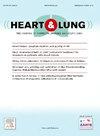The role of cardiac positron emission tomography in prediction of atrial fibrillation rhythm: A systematic review and meta-analysis
IF 2.6
4区 医学
Q2 CARDIAC & CARDIOVASCULAR SYSTEMS
引用次数: 0
Abstract
Background
Atrial fibrillation (AF), the most common cardiac arrhythmia, is driven by inflammation-induced fibrosis and remodeling. Positron emission tomography (PET) offers a promising alternative by visualizing metabolic and inflammatory activity in cardiac tissue. Objectives: Evaluate PET's role in predicting AF to improve risk stratification and patient outcomes.
Methods
Systematic review of PubMed, Scopus, Web of Science, EMBASE was conducted using PRISMA guidelines. Our meta-analysis was registered in PROSPERO (CRD42024602021). Studies comparing quantitative PET scan parameters in AF versus non-AF patients were included. Random-effects models were performed using standardized mean differences (SMD) with 95 % Confidence intervals (CIs). Sensitivity analyses and publication bias with Egger's test and meta-regression analyses were performed.
Results
Ten studies with 1145 participants (661 with AF, 484 controls) were included. Patients with AF demonstrated significantly higher maximum SUV in the left atrium (LA) (SMD: 0.62, 95 % CI 0.41–0.83), left atrial appendage (LAA) (SMD: 0.78, 95 % CI 0.41–1.15), right atrium (RA) (SMD: 1.00, 95 % CI 0.72–1.27), and right atrial appendage (RAA) (SMD: 0.89, 95 % CI 0.63–1.14), but no significant differences in mean SUV or left ventricle (LV) metrics. Target-to-background ratios (TBR) were also significantly elevated in the LA, LAA, RA, and RAA in AF patients (p < 0.01).
Conclusion
Inflammation and AF suggest a bidirectional relationship as supported by cardiac FDG-PET imaging. Early detection using PET scans can enhance AF management by preventing irreversible cardiac damage.
心脏正电子发射断层扫描在预测心房颤动节律中的作用:系统回顾和荟萃分析
心房纤颤(AF)是最常见的心律失常,由炎症诱导的纤维化和重构驱动。正电子发射断层扫描(PET)提供了一种很有前途的替代方法,通过可视化心脏组织中的代谢和炎症活动。目的:评估PET在预测房颤中的作用,以改善风险分层和患者预后。方法采用PRISMA指南对PubMed、Scopus、Web of Science、EMBASE进行系统评价。我们的荟萃分析已在PROSPERO注册(CRD42024602021)。包括比较房颤与非房颤患者定量PET扫描参数的研究。随机效应模型采用95%置信区间(ci)的标准化平均差(SMD)。采用Egger检验和meta回归分析进行敏感性分析和发表偏倚分析。结果共纳入10项研究,共1145名受试者(AF患者661名,对照组484名)。房颤患者在左心房(LA) (SMD: 0.62, 95% CI 0.41-0.83)、左心房附件(LAA) (SMD: 0.78, 95% CI 0.41-1.15)、右心房(RA) (SMD: 1.00, 95% CI 0.72-1.27)和右心房附件(RAA) (SMD: 0.89, 95% CI 0.63-1.14)的最大SUV显著升高,但在平均SUV或左心室(LV)指标上无显著差异。AF患者的LA、LAA、RA和RAA的靶本比(TBR)也显著升高(p < 0.01)。结论心脏FDG-PET显示炎症与房颤呈双向关系。PET扫描的早期检测可以通过预防不可逆的心脏损伤来加强房颤的管理。
本文章由计算机程序翻译,如有差异,请以英文原文为准。
求助全文
约1分钟内获得全文
求助全文
来源期刊

Heart & Lung
医学-呼吸系统
CiteScore
4.60
自引率
3.60%
发文量
184
审稿时长
35 days
期刊介绍:
Heart & Lung: The Journal of Cardiopulmonary and Acute Care, the official publication of The American Association of Heart Failure Nurses, presents original, peer-reviewed articles on techniques, advances, investigations, and observations related to the care of patients with acute and critical illness and patients with chronic cardiac or pulmonary disorders.
The Journal''s acute care articles focus on the care of hospitalized patients, including those in the critical and acute care settings. Because most patients who are hospitalized in acute and critical care settings have chronic conditions, we are also interested in the chronically critically ill, the care of patients with chronic cardiopulmonary disorders, their rehabilitation, and disease prevention. The Journal''s heart failure articles focus on all aspects of the care of patients with this condition. Manuscripts that are relevant to populations across the human lifespan are welcome.
 求助内容:
求助内容: 应助结果提醒方式:
应助结果提醒方式:


